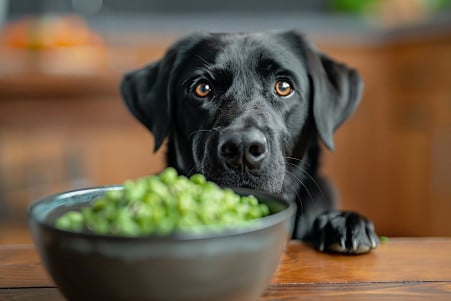Can Dogs Eat Lentils? Benefits and Potential Risks
4 June 2024 • Updated 3 June 2024

As more and more dog owners seek out plant-based protein options for their pets, lentils have become an increasingly popular choice. And while lentils can be a healthy and nutritious option for dogs, there are some important things to keep in mind before adding them to your pet's diet.
When prepared and served correctly, lentils can be a great source of protein, fiber, folate, and iron for dogs. But, as with any new food, it's important to consider your dog's individual needs, as well as how lentils will fit into their overall diet. In this article, we'll take a look at the latest veterinary research and dietary recommendations to help you better understand the benefits and potential risks of feeding lentils to your dog. By the end, you'll have the information you need to decide whether or not lentils are a good choice for your pet's overall, well-balanced, and species-appropriate diet.
Can dogs eat lentils?
Nutritional Benefits of Lentils for Dogs
Lentils are a great source of plant-based protein, which is important for muscle repair and growth in dogs. They are also high in dietary fiber, which helps with digestion and keeps dogs feeling full, so lentils can be helpful for dogs that need to lose weight.
Lentils also have a number of minerals, including iron, folate, and magnesium, that are important for a variety of bodily functions. They can also help manage blood sugar because they are low in calories and high in fiber, so they can be a good addition to the diet of a dog with diabetes. In addition, lentils are thought to have other health benefits, including helping with heart health and providing antioxidants.
In general, lentils can be a healthy part of a dog's diet, especially when they are prepared correctly and given in moderation as part of a complete and balanced diet. Their nutritional content means they are a good source of plant-based protein and fiber, which can help support a dog's health in a number of ways.
Potential Risks and Concerns of Lentils for Dogs
Even though lentils can be a nutritious addition to a dog's diet, there are some potential risks and concerns to keep in mind. The FDA warns that raw or undercooked lentils can be hard for dogs to digest, which can lead to gastrointestinal issues such as bloating, gas, and discomfort. This is because lentils contain lectins, which can be hard for dogs to digest if they aren't soaked and cooked properly.
There have been some concerns that lentil-based dog foods could be linked to dilated cardiomyopathy (DCM), a type of heart disease, but the Merck Veterinary Manual explains that the relationship between lentils and DCM is not well understood. In addition, although it's rare, some dogs may develop allergies or sensitivities to lentils, which can cause skin problems or vomiting.
It's important to feed dogs lentils in moderation because if they eat too many, it can lead to nutrient imbalances or deficiencies if they aren't part of a well-rounded diet. Making sure lentils are prepared properly and fed in the right portion sizes can help reduce these risks.
How to Cook and Feed Lentils to Dogs
Lentils must be cooked before feeding them to dogs, as raw lentils can lead to digestive upset. ButtnutBox explains that lentils can be boiled, steamed, or cooked in a slow cooker or Instant Pot to make sure they are soft and easy to digest.
Lentils should be introduced to dogs in small amounts, such as 1 teaspoon to 1 tablespoon per meal, and then increased as the dog gets used to them. The Almond Eater says lentils can be added as a topper or mixed in with a dog's regular food, and can be combined with other ingredients like vegetables, grains, and lean proteins.
It's important to talk to a vet or pet nutritionist to figure out how much lentils to feed a dog based on their breed, size, activity level, and other dietary factors. CanDogEatIt.com says that in general, 1 tablespoon of cooked lentils can be fed to dogs 1-2 times per week.
Lentils in Homemade Dog Food Recipes
Lentils can be a healthy and budget-friendly addition to homemade dog food recipes, as they offer plant-based protein and fiber. Per Azestfor, lentils are often used in combination with other ingredients like lean meats, vegetables, grains, and healthy oils to ensure that the resulting meal is nutritionally complete. Some recipes are designed for easy batch cooking and freezing, which can help make the process of feeding your dog a homemade diet more manageable.
It's important to ensure that homemade dog food includes the right proportions of protein, carbohydrates, fats, and essential nutrients to meet your dog's nutritional needs. Per Edible Indy, a good starting point is to look for 25–30% protein, 50% carbohydrates, 10% fiber and 10% fat. Working with a veterinary nutritionist will ensure that you can develop recipes that are tailored to your dog's specific dietary and health needs.
Lentils and Special Dietary Needs in Dogs
For dogs with kidney disease, plant-based protein sources like lentils may be used instead of animal protein sources to reduce the workload on the kidneys, says PetMD. However, lentils are high in phosphorus, which is a nutrient that needs to be restricted in the diets of dogs with chronic kidney disease. As pointed out by Food Politics, the FDA has received reports of dogs that were fed grain-free pet foods, which often contain lentils, that developed dilated cardiomyopathy (DCM), although this association is still being studied.
According to Rocky Kanaka, lentils and legumes should be restricted in the diets of dogs with kidney disease because they are high in protein and phosphorus. BeyondPets.com also suggests restricting beans and legumes for dogs with chronic kidney disease because they are high in phosphorus.
On the other hand, dogs with diabetes or weight issues may benefit from lentils' low-calorie, high-fiber content. However, it's important to feed them in moderation. If you're feeding lentils to a dog with a health condition or special dietary needs, it's best to work with a veterinary nutritionist to ensure that you're meeting your dog's nutritional needs.
Conclusion: How to Introduce Lentils Into Your Dog's Diet
Lentils can be a valuable addition to your dog's diet, providing a plant-based source of protein, essential amino acids, and fiber. However, it's important to introduce lentils gradually and in moderation to avoid potential side effects.
According to Vital Pet Life, it's also important to make sure you prepare lentils properly before giving them to your dog, as raw lentils can be hard for dogs to digest.
While lentils can be a nutritious addition to your dog's diet, overconsumption and eating raw lentils can cause digestive issues, such as gas, bloating, or discomfort. Pure Pet Food also warns that lectins in lentils can affect nutrient absorption, so they should be fed in moderation and as part of a balanced diet.
If you do feed your dog lentils, make sure to watch them for signs of digestive upset, such as diarrhea, vomiting, or lethargy. Vital Pet Life also recommends that you consider adding salmon oil to your dog's diet to help reduce any irritation or inflammation that lentils may cause, as omega-3 fatty acids are known for their anti-inflammatory effects.
In general, lentils can be a healthy addition to your dog's diet, but it's important to introduce them gradually and in moderation. It's also important to be aware of potential side effects and to talk to your vet or a pet nutritionist to make sure you're introducing lentils in a way that's safe and appropriate for your dog.


